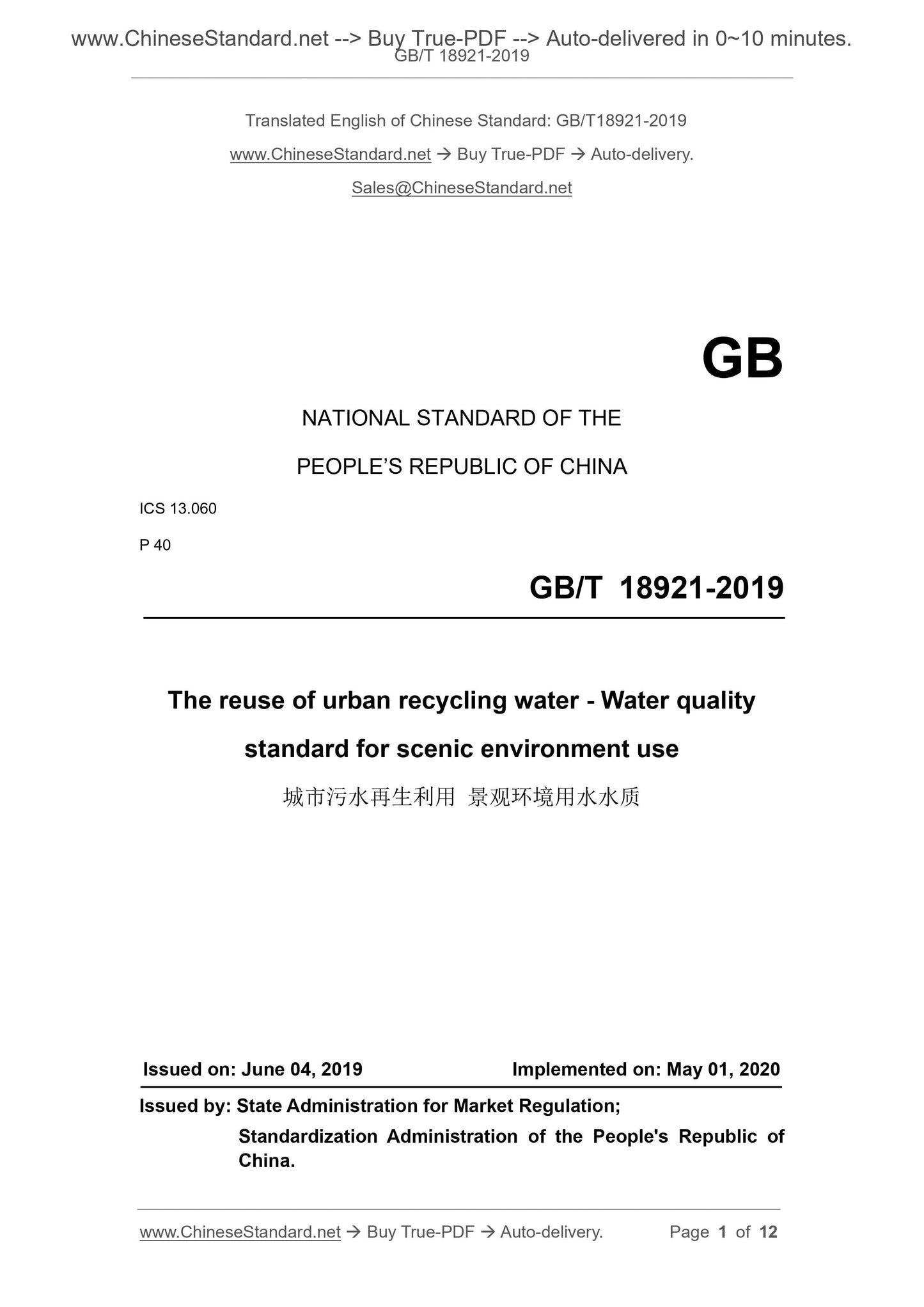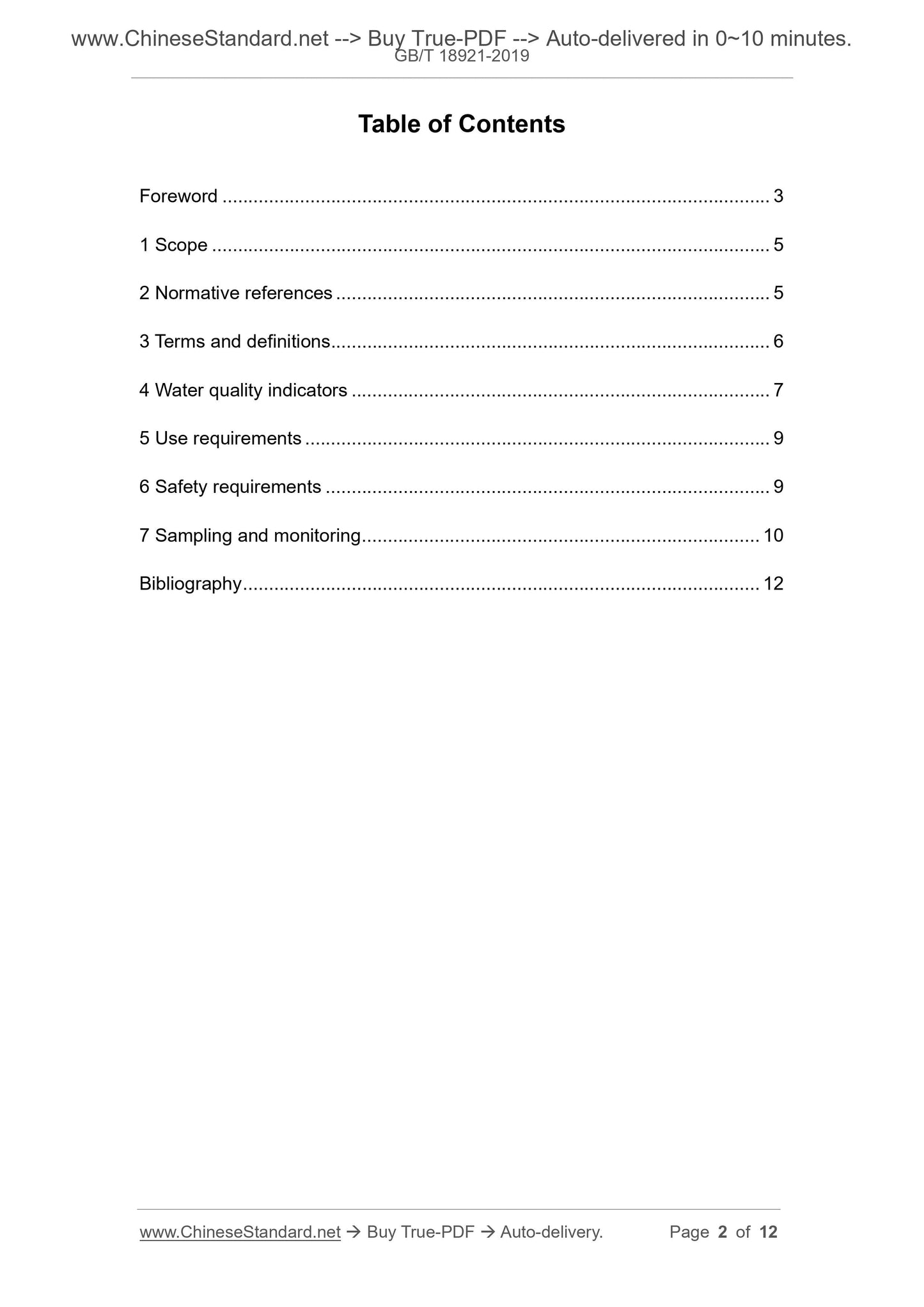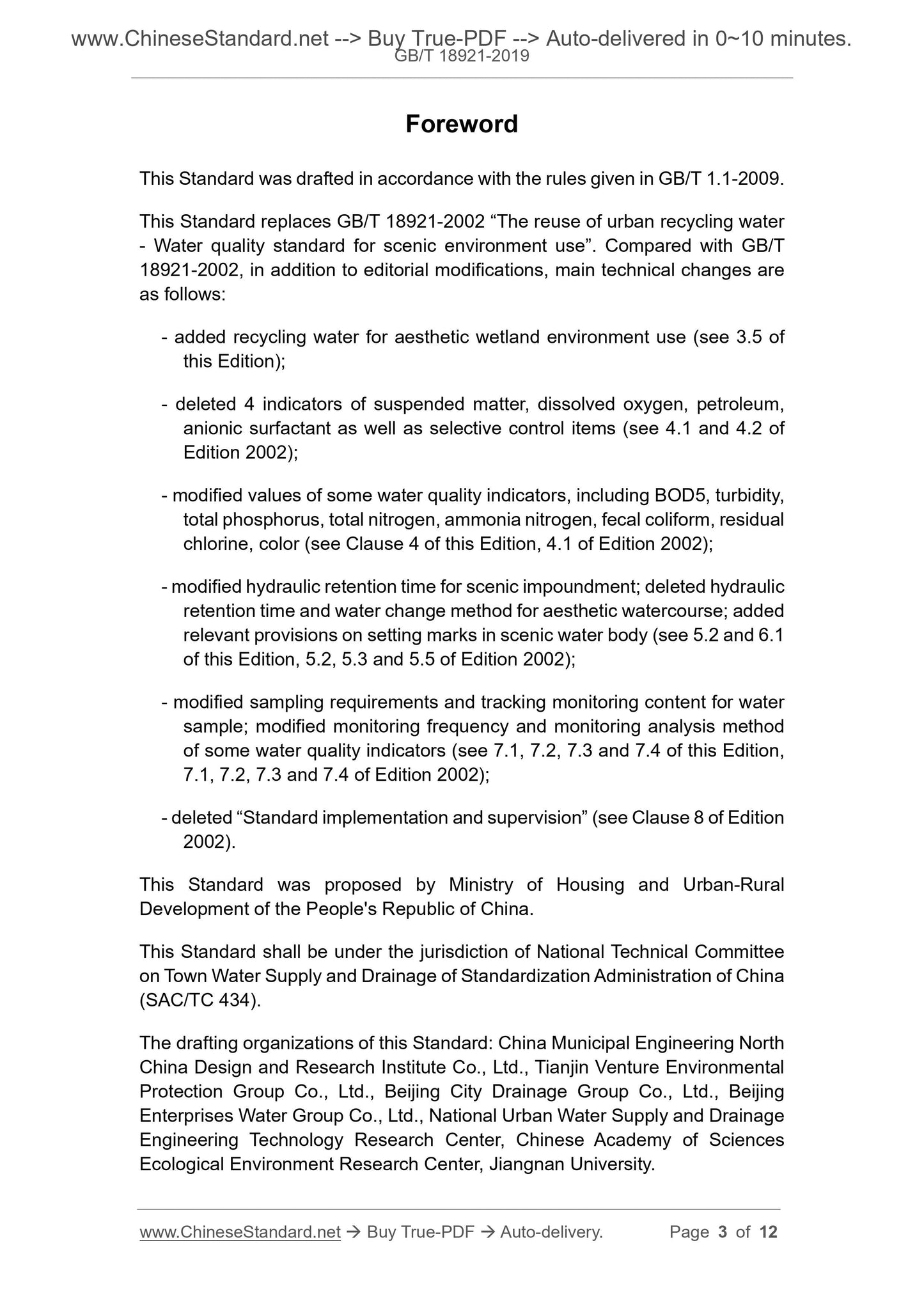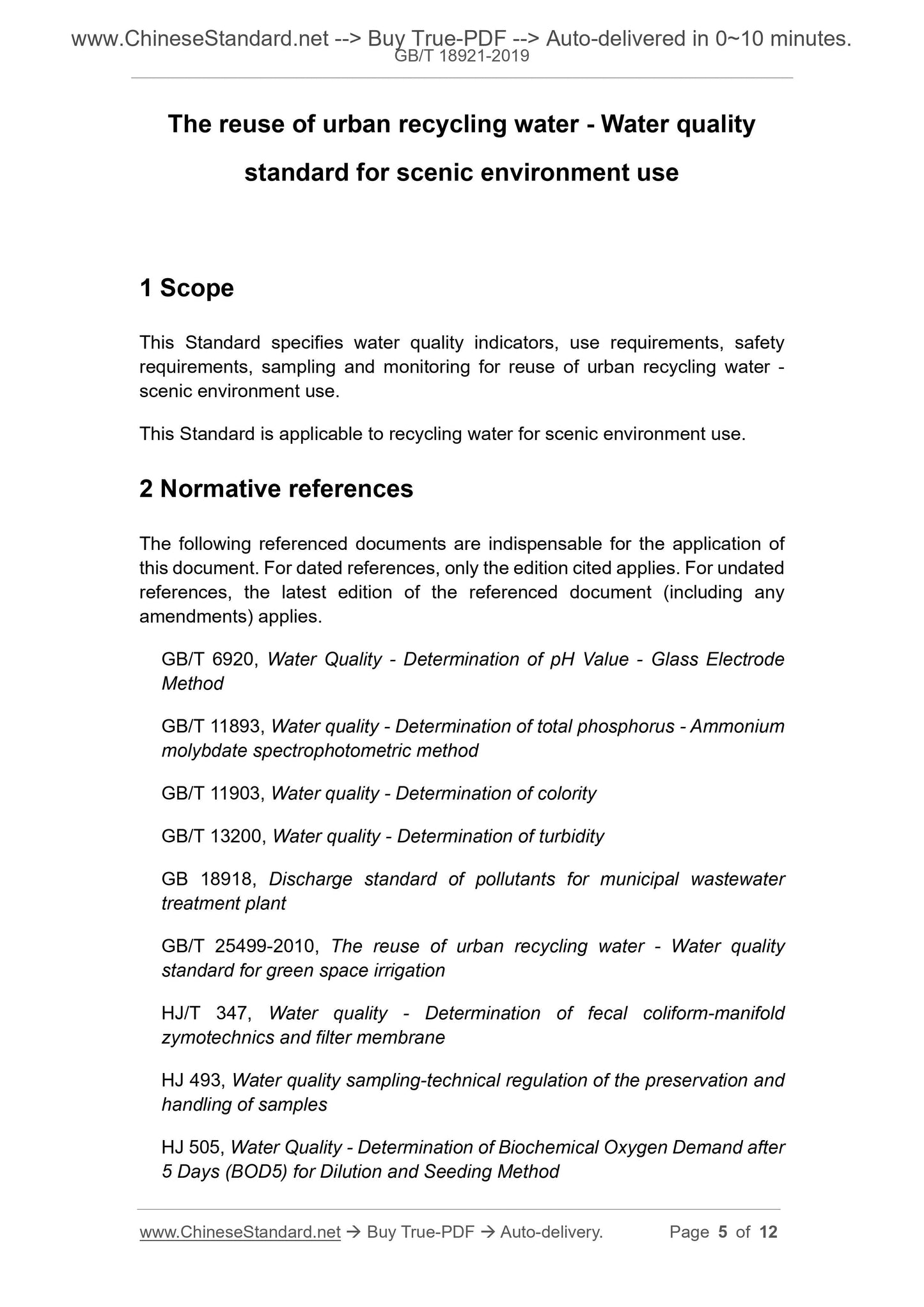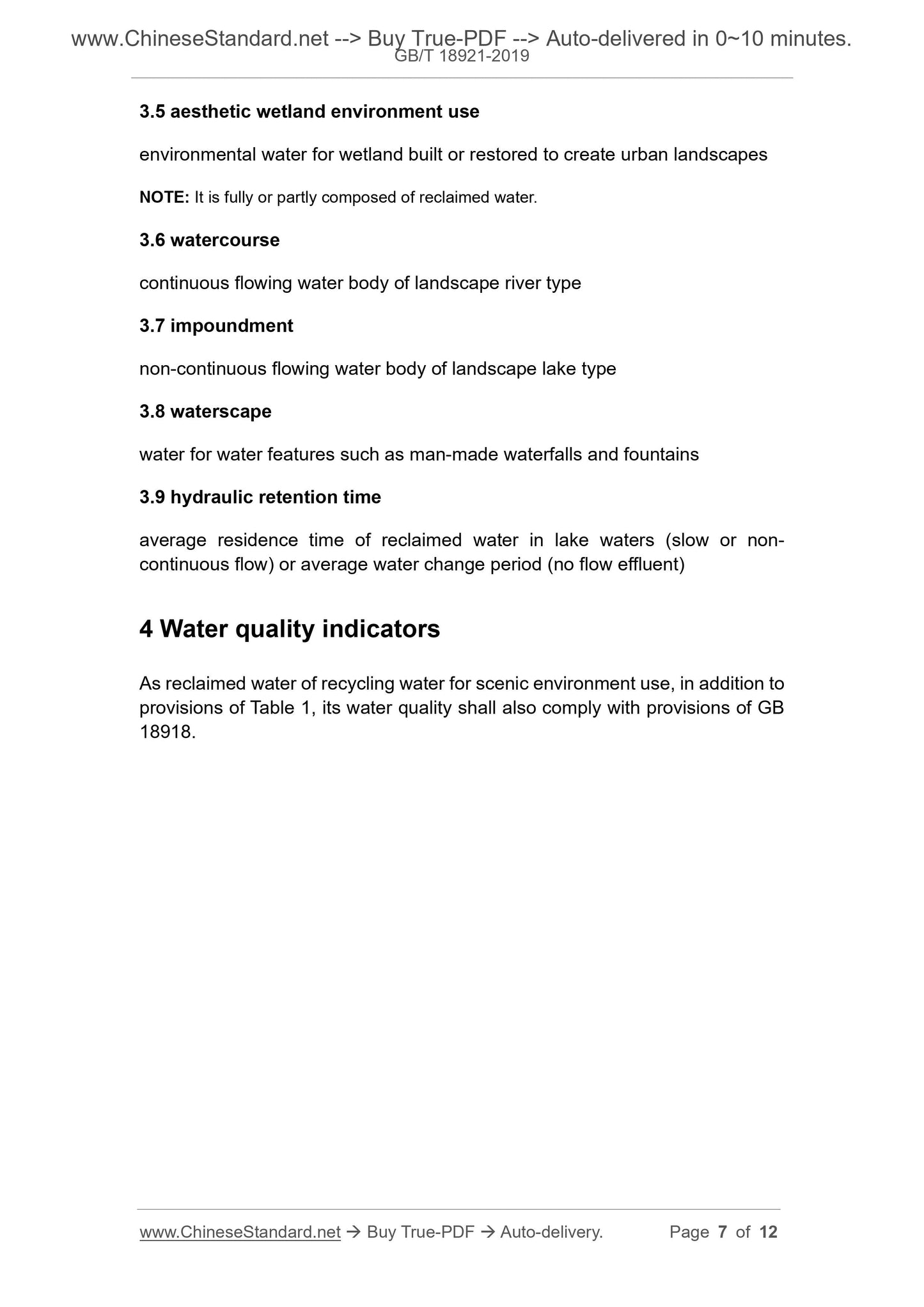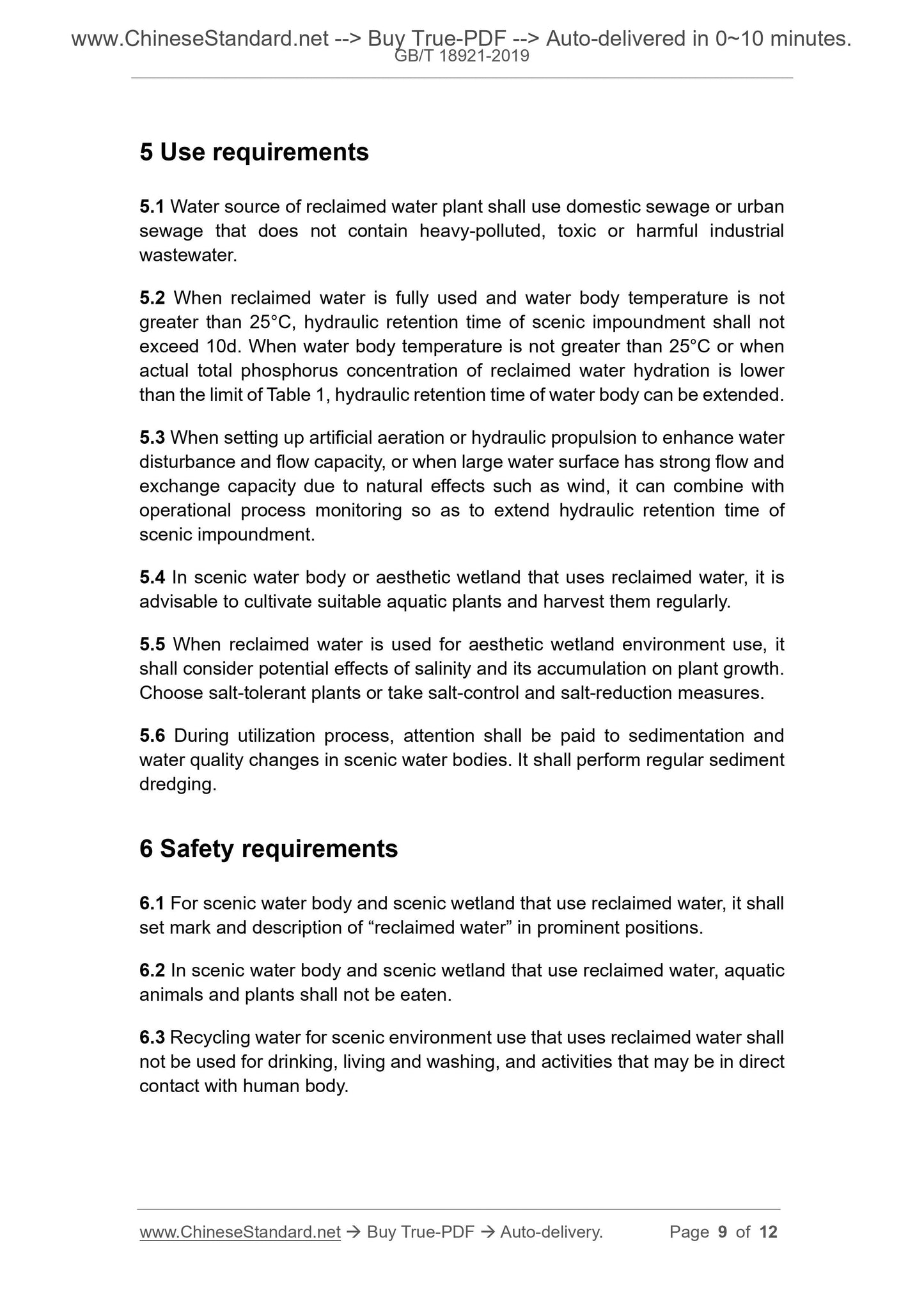1
/
of
6
PayPal, credit cards. Download editable-PDF and invoice in 1 second!
GB/T 18921-2019 English PDF (GBT18921-2019)
GB/T 18921-2019 English PDF (GBT18921-2019)
Regular price
$150.00 USD
Regular price
Sale price
$150.00 USD
Unit price
/
per
Shipping calculated at checkout.
Couldn't load pickup availability
Delivery: 3 seconds. Download true-PDF + Invoice.
Get QUOTATION in 1-minute: Click GB/T 18921-2019
Historical versions: GB/T 18921-2019
Preview True-PDF (Reload/Scroll if blank)
GB/T 18921-2019: The reuse of urban recycling water -- Water quality standard for scenic environment use
GB/T 18921-2019
NATIONAL STANDARD OF THE
PEOPLE’S REPUBLIC OF CHINA
ICS 13.060
P 40
The reuse of urban recycling water - Water quality
standard for scenic environment use
ISSUED ON: JUNE 04, 2019
IMPLEMENTED ON: MAY 01, 2020
Issued by: State Administration for Market Regulation;
Standardization Administration of the People's Republic of
China.
Table of Contents
Foreword ... 3
1 Scope ... 5
2 Normative references ... 5
3 Terms and definitions ... 6
4 Water quality indicators ... 7
5 Use requirements ... 9
6 Safety requirements ... 9
7 Sampling and monitoring ... 10
Bibliography ... 12
Foreword
This Standard was drafted in accordance with the rules given in GB/T 1.1-2009.
This Standard replaces GB/T 18921-2002 “The reuse of urban recycling water
- Water quality standard for scenic environment use”. Compared with GB/T
18921-2002, in addition to editorial modifications, main technical changes are
as follows:
- added recycling water for aesthetic wetland environment use (see 3.5 of
this Edition);
- deleted 4 indicators of suspended matter, dissolved oxygen, petroleum,
anionic surfactant as well as selective control items (see 4.1 and 4.2 of
Edition 2002);
- modified values of some water quality indicators, including BOD5, turbidity,
total phosphorus, total nitrogen, ammonia nitrogen, fecal coliform, residual
chlorine, color (see Clause 4 of this Edition, 4.1 of Edition 2002);
- modified hydraulic retention time for scenic impoundment; deleted hydraulic
retention time and water change method for aesthetic watercourse; added
relevant provisions on setting marks in scenic water body (see 5.2 and 6.1
of this Edition, 5.2, 5.3 and 5.5 of Edition 2002);
- modified sampling requirements and tracking monitoring content for water
sample; modified monitoring frequency and monitoring analysis method
of some water quality indicators (see 7.1, 7.2, 7.3 and 7.4 of this Edition,
7.1, 7.2, 7.3 and 7.4 of Edition 2002);
- deleted “Standard implementation and supervision” (see Clause 8 of Edition
2002).
This Standard was proposed by Ministry of Housing and Urban-Rural
Development of the People's Republic of China.
This Standard shall be under the jurisdiction of National Technical Committee
on Town Water Supply and Drainage of Standardization Administration of China
(SAC/TC 434).
The drafting organizations of this Standard: China Municipal Engineering North
China Design and Research Institute Co., Ltd., Tianjin Venture Environmental
Protection Group Co., Ltd., Beijing City Drainage Group Co., Ltd., Beijing
Enterprises Water Group Co., Ltd., National Urban Water Supply and Drainage
Engineering Technology Research Center, Chinese Academy of Sciences
Ecological Environment Research Center, Jiangnan University.
The reuse of urban recycling water - Water quality
standard for scenic environment use
1 Scope
This Standard specifies water quality indicators, use requirements, safety
requirements, sampling and monitoring for reuse of urban recycling water -
scenic environment use.
This Standard is applicable to recycling water for scenic environment use.
2 Normative references
The following referenced documents are indispensable for the application of
this document. For dated references, only the edition cited applies. For undated
references, the latest edition of the referenced document (including any
amendments) applies.
GB/T 6920, Water Quality - Determination of pH Value - Glass Electrode
Method
GB/T 11893, Water quality - Determination of total phosphorus - Ammonium
molybdate spectrophotometric method
GB/T 11903, Water quality - Determination of colority
GB/T 13200, Water quality - Determination of turbidity
GB 18918, Discharge standard of pollutants for municipal wastewater
treatment plant
GB/T 25499-2010, The reuse of urban recycling water - Water quality
standard for green space irrigation
HJ/T 347, Water quality - Determination of fecal coliform-manifold
zymotechnics and filter membrane
HJ 493, Water quality sampling-technical regulation of the preservation and
handling of samples
HJ 505, Water Quality - Determination of Biochemical Oxygen Demand after
5 Days (BOD5) for Dilution and Seeding Method
3.5 aesthetic wetland environment use
environmental water for wetland built or restored to create urban landscapes
NOTE: It is fully or partly composed of reclaimed water.
3.6 watercourse
continuous flowing water body of landscape river type
3.7 impoundment
non-continuous flowing water body of landscape lake type
3.8 waterscape
water for water features such as man-made waterfalls and fountains
3.9 hydraulic retention time
average residence time of reclaimed water in lake waters (slow or non-
continuous flow) or average water change period (no flow effluent)
4 Water quality indicators
As reclaimed water of recycling water for scenic environment use, in addition to
provisions of Table 1, its water quality shall also comply with provisions of GB
18918.
5 Use requirements
5.1 Water source of reclaimed water plant shall use domestic sewage or urban
sewage that does not contain heavy-polluted, toxic or harmful industrial
wastewater.
5.2 When reclaimed water is fully used and water body temperature is not
greater than 25°C, hydraulic retention time of scenic impoundment shall not
exceed 10d. When water body temperature is not greater than 25°C or when
actual total phosphorus concentration of reclaimed water hydration is lower
than the limit of Table 1, hydraulic retention time of water body can be extended.
5.3 When setting up artificial aeration or hydraulic propulsion to enhance water
disturbance and flow capacity, or when large water surface has strong flow and
exchange capacity due to natural effects such as wind, it can combine with
operational process monitoring so as to extend hydraulic retention time of
scenic impoundment.
5.4 In scenic water body or aesthetic wetland that uses reclaimed water, it is
advisable to cultivate suitable aquatic plants and harvest them regularly.
5.5 When reclaimed water is used for aesthetic wetland environment use, it
shall consider potential effects of salinity and its accumulation on plant growth.
Choose salt-tolerant plants or take salt-control and salt-reduction measures.
5.6 During utilization process, attention shall be paid to sedimentation and
water quality changes in scenic water bodies. It shall perform regular sediment
dredging.
6 Safety requirements
6.1 For scenic water body and scenic wetland that use reclaimed water, it shall
set mark and description of “reclaimed water” in prominent positions.
6.2 In scenic water body and scenic wetland that use reclaimed water, aquatic
animals and plants shall not be eaten.
6.3 Recycling water for scenic environment use that uses reclaimed water shall
not be used for drinking, living and washing, and activities that may be in direct
contact with human body.
Get QUOTATION in 1-minute: Click GB/T 18921-2019
Historical versions: GB/T 18921-2019
Preview True-PDF (Reload/Scroll if blank)
GB/T 18921-2019: The reuse of urban recycling water -- Water quality standard for scenic environment use
GB/T 18921-2019
NATIONAL STANDARD OF THE
PEOPLE’S REPUBLIC OF CHINA
ICS 13.060
P 40
The reuse of urban recycling water - Water quality
standard for scenic environment use
ISSUED ON: JUNE 04, 2019
IMPLEMENTED ON: MAY 01, 2020
Issued by: State Administration for Market Regulation;
Standardization Administration of the People's Republic of
China.
Table of Contents
Foreword ... 3
1 Scope ... 5
2 Normative references ... 5
3 Terms and definitions ... 6
4 Water quality indicators ... 7
5 Use requirements ... 9
6 Safety requirements ... 9
7 Sampling and monitoring ... 10
Bibliography ... 12
Foreword
This Standard was drafted in accordance with the rules given in GB/T 1.1-2009.
This Standard replaces GB/T 18921-2002 “The reuse of urban recycling water
- Water quality standard for scenic environment use”. Compared with GB/T
18921-2002, in addition to editorial modifications, main technical changes are
as follows:
- added recycling water for aesthetic wetland environment use (see 3.5 of
this Edition);
- deleted 4 indicators of suspended matter, dissolved oxygen, petroleum,
anionic surfactant as well as selective control items (see 4.1 and 4.2 of
Edition 2002);
- modified values of some water quality indicators, including BOD5, turbidity,
total phosphorus, total nitrogen, ammonia nitrogen, fecal coliform, residual
chlorine, color (see Clause 4 of this Edition, 4.1 of Edition 2002);
- modified hydraulic retention time for scenic impoundment; deleted hydraulic
retention time and water change method for aesthetic watercourse; added
relevant provisions on setting marks in scenic water body (see 5.2 and 6.1
of this Edition, 5.2, 5.3 and 5.5 of Edition 2002);
- modified sampling requirements and tracking monitoring content for water
sample; modified monitoring frequency and monitoring analysis method
of some water quality indicators (see 7.1, 7.2, 7.3 and 7.4 of this Edition,
7.1, 7.2, 7.3 and 7.4 of Edition 2002);
- deleted “Standard implementation and supervision” (see Clause 8 of Edition
2002).
This Standard was proposed by Ministry of Housing and Urban-Rural
Development of the People's Republic of China.
This Standard shall be under the jurisdiction of National Technical Committee
on Town Water Supply and Drainage of Standardization Administration of China
(SAC/TC 434).
The drafting organizations of this Standard: China Municipal Engineering North
China Design and Research Institute Co., Ltd., Tianjin Venture Environmental
Protection Group Co., Ltd., Beijing City Drainage Group Co., Ltd., Beijing
Enterprises Water Group Co., Ltd., National Urban Water Supply and Drainage
Engineering Technology Research Center, Chinese Academy of Sciences
Ecological Environment Research Center, Jiangnan University.
The reuse of urban recycling water - Water quality
standard for scenic environment use
1 Scope
This Standard specifies water quality indicators, use requirements, safety
requirements, sampling and monitoring for reuse of urban recycling water -
scenic environment use.
This Standard is applicable to recycling water for scenic environment use.
2 Normative references
The following referenced documents are indispensable for the application of
this document. For dated references, only the edition cited applies. For undated
references, the latest edition of the referenced document (including any
amendments) applies.
GB/T 6920, Water Quality - Determination of pH Value - Glass Electrode
Method
GB/T 11893, Water quality - Determination of total phosphorus - Ammonium
molybdate spectrophotometric method
GB/T 11903, Water quality - Determination of colority
GB/T 13200, Water quality - Determination of turbidity
GB 18918, Discharge standard of pollutants for municipal wastewater
treatment plant
GB/T 25499-2010, The reuse of urban recycling water - Water quality
standard for green space irrigation
HJ/T 347, Water quality - Determination of fecal coliform-manifold
zymotechnics and filter membrane
HJ 493, Water quality sampling-technical regulation of the preservation and
handling of samples
HJ 505, Water Quality - Determination of Biochemical Oxygen Demand after
5 Days (BOD5) for Dilution and Seeding Method
3.5 aesthetic wetland environment use
environmental water for wetland built or restored to create urban landscapes
NOTE: It is fully or partly composed of reclaimed water.
3.6 watercourse
continuous flowing water body of landscape river type
3.7 impoundment
non-continuous flowing water body of landscape lake type
3.8 waterscape
water for water features such as man-made waterfalls and fountains
3.9 hydraulic retention time
average residence time of reclaimed water in lake waters (slow or non-
continuous flow) or average water change period (no flow effluent)
4 Water quality indicators
As reclaimed water of recycling water for scenic environment use, in addition to
provisions of Table 1, its water quality shall also comply with provisions of GB
18918.
5 Use requirements
5.1 Water source of reclaimed water plant shall use domestic sewage or urban
sewage that does not contain heavy-polluted, toxic or harmful industrial
wastewater.
5.2 When reclaimed water is fully used and water body temperature is not
greater than 25°C, hydraulic retention time of scenic impoundment shall not
exceed 10d. When water body temperature is not greater than 25°C or when
actual total phosphorus concentration of reclaimed water hydration is lower
than the limit of Table 1, hydraulic retention time of water body can be extended.
5.3 When setting up artificial aeration or hydraulic propulsion to enhance water
disturbance and flow capacity, or when large water surface has strong flow and
exchange capacity due to natural effects such as wind, it can combine with
operational process monitoring so as to extend hydraulic retention time of
scenic impoundment.
5.4 In scenic water body or aesthetic wetland that uses reclaimed water, it is
advisable to cultivate suitable aquatic plants and harvest them regularly.
5.5 When reclaimed water is used for aesthetic wetland environment use, it
shall consider potential effects of salinity and its accumulation on plant growth.
Choose salt-tolerant plants or take salt-control and salt-reduction measures.
5.6 During utilization process, attention shall be paid to sedimentation and
water quality changes in scenic water bodies. It shall perform regular sediment
dredging.
6 Safety requirements
6.1 For scenic water body and scenic wetland that use reclaimed water, it shall
set mark and description of “reclaimed water” in prominent positions.
6.2 In scenic water body and scenic wetland that use reclaimed water, aquatic
animals and plants shall not be eaten.
6.3 Recycling water for scenic environment use that uses reclaimed water shall
not be used for drinking, living and washing, and activities that may be in direct
contact with human body.
Share
